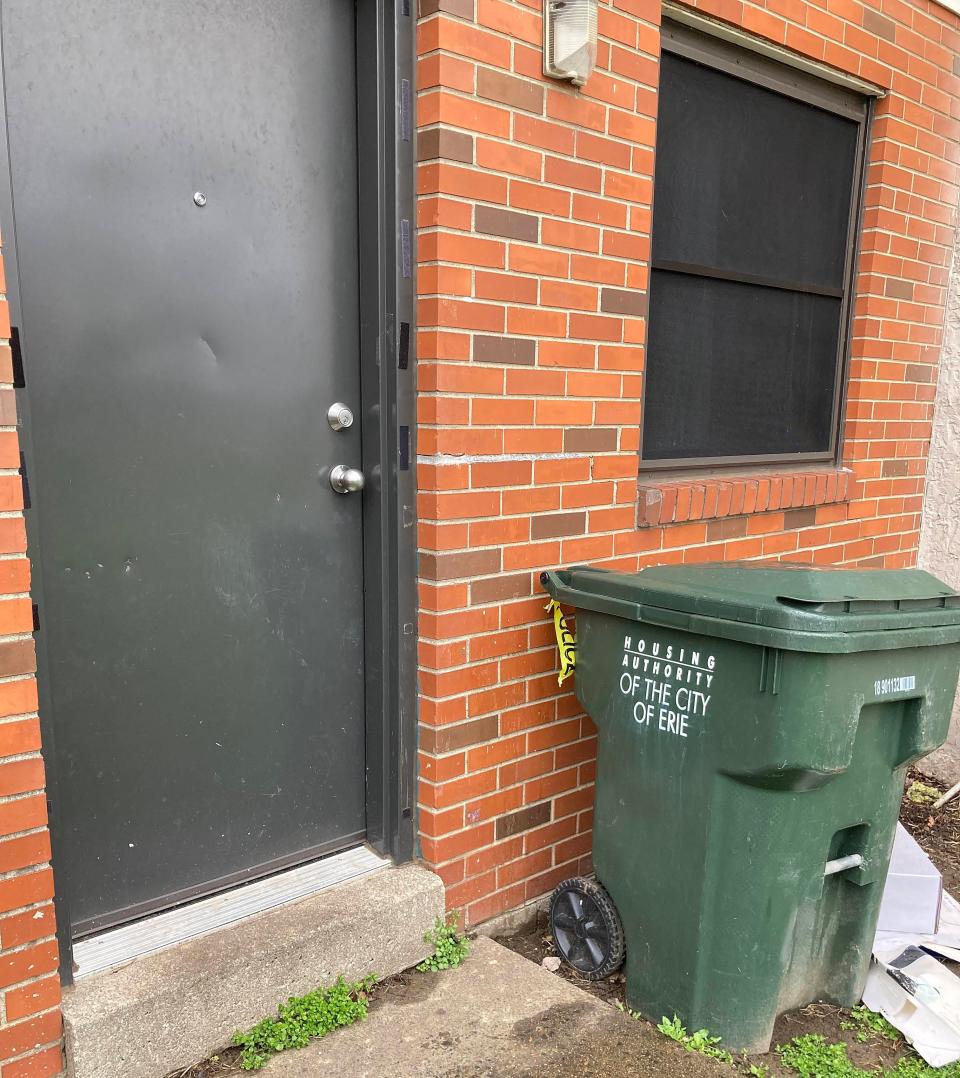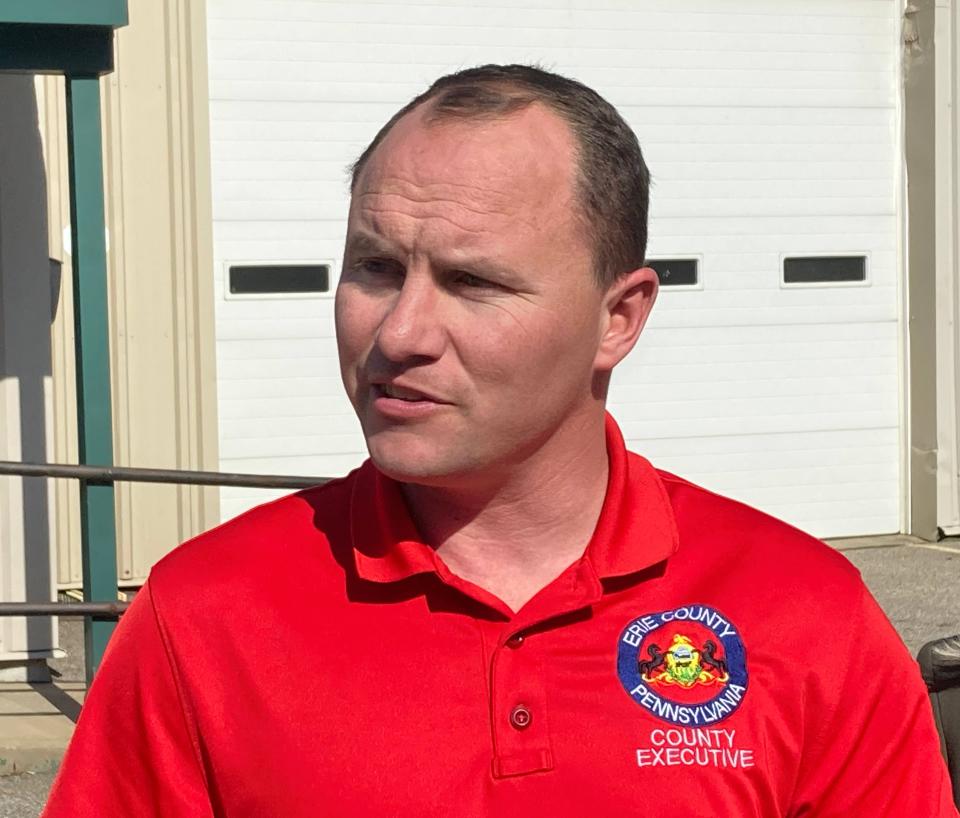Despite law that OKs disclosure, Erie County is mum on OCY and toddler who froze to death
After 2-year-old Zemina Smith was found frozen to death near her apartment on Erie's East 17th Street on Feb. 29, her case raised a number of questions. They included whether the Erie County Office of Children and Youth was involved with her family before she died.
The questions about OCY's involvement grew weeks later.
A coroner's report filed April 2 indicated Zemina had died of hypothermia. The report also revealed that Zemina's mother told police she and Zemina's father had used methamphetamine the evening that Zemina left their apartment and wandered outside, wearing only shorts and a T-shirt as the temperature dipped to 25 degrees and the wind chill dropped to 8 or 9 degrees.
The administration of Erie County Executive Brenton Davis, which oversees OCY, is refusing to release information that could help answer questions about Zemina's death.
The Davis administration is refusing to disclose the information despite a state law that authorizes county governments to release certain initial and basic details about a child fatality or near fatality in which child abuse is suspected or confirmed.

The law allows the release of the information even if a case is under criminal investigation, as is Zemina's. The Erie County District Attorney's Office is continuing to review the case.
The Davis administration stood by its refusal to release information after the Erie Times-News asked the administration to reconsider its position in light of the state law that allows for certain disclosures, Act 44 of 2014.
As evidence that the law allows such a release, the Erie Times-News ended up getting the same information from the state Department of Human Services that the newspaper had requested from the Davis administration.
Act 44 of 2014 allows DHS and county governments to disclose the information if they choose to do so. Release of the information is not mandatory. DHS and a county "may release" the information, the law states.
The information that DHS released — and that the county refused to release — is limited under Act 44 due to privacy concerns. But the information that DHS released shows that OCY is not believed to have been involved with Zemina and her family because they were not receiving public or private child welfare services when she died.
"There were no public or private agencies under contract with the county agency providing services to the child and the child’s family," DHS said in an email.
Law says certain types of information may be released
DHS made that disclosure under the section of Act 44 that allows DHS or a county government to release "information to the public concerning a child who died or nearly died as a result of suspected or substantiated child abuse."
The law allows for the release of the information before the county or the DHS completes a mandatory report of a child fatality or near fatality. The county and DHS must undertake those reports if child abuse is suspected or confirmed, even if a child protective service agency, such as OCY, was not involved with the child prior to the death or near death. The reports in Zemina's case are not yet available.
Under Act 44, the areas in which the county and DHS "may release" information in the early stage of a case are:
● "The identity of the child if it is a fatality." In response to a request from the Erie Times-News, DHS released Zemina's name, which was already public.
● If the child was in the custody of a public or private agency, the identity of the agency.
In Zemina's case, "the child was not in the custody of a public or private agency," DHS told the Erie Times-News in an email. Zemina was already known to have been living with her parents when she died.
● "The identity of the public or private agency under contract with a county agency to provide services to the child and the child's family in the child's home prior to the child's death or near fatality." DHS responded with the statement, "There were no public or private agencies under contract with the county agency providing services to the child and the child’s family."
● "A description of services provided under" the above category. DHS said the information was not applicable to Zemina's case because no services were provided.
● "The identity of the county agency that convened a child fatality or near fatality review team with respect to the child." DHS said Erie County convened the review team.
Why is Davis administration not releasing information?
After Zemina's death, the Erie Times-News asked the Davis administration if OCY was involved with Zemina's family because three other children were also in the apartment when she died.

The spokesman for the administration, Chris Carroll, responded that "We are unable to offer any specific comment that would confirm or deny the existence of an active case with the Erie County Office of Children and Youth." In general, Carroll also said, OCY "follows all federal, state and local regulations to provide for the safety, permanency and well-being of all Erie County children."
In response, the Times-News asked Carroll to provide more details about Zemina's case under the disclosure provisions of Act 44. The Times-News emailed Carroll a link to Act 44 and cited the section that allows for disclosure.
"The county will stand by its original statement on this matter," Carroll responded in an email.
The Times-News then emailed Carroll asking that the county reconsider its position because of the disclosure provisions in Act 44. In an email, the newspaper asked Carroll to explain why the county was refusing to disclose information that it is allowed to release under the law, "including information on whether OCY was involved with Zemina's family before she died."

With Carroll out of town, Davis' director of administration, Joe Sinnott, the former mayor of Erie, responded in an email on Monday.
"The county executive and the departments under his administration have previously offered the responses that we believe are appropriate and adequate in matters such as this," Sinnott said. "The County has a well-established policy regarding the dissemination of information in these instances and will adhere to it."
Sinnott also said Davis would not make himself available for an interview on why his administration chose not to release information that the law says it may disclose.
"The county executive won’t be commenting any further on this matter, at this time, as we don’t believe it is appropriate in light of the on-going investigation," Sinnott said in an email.
Counties asked for measure that Davis administration is not using
In refusing to release information on Zemina's case, the Davis administration is declining to avail itself of an option in state law that counties themselves lobbied for, said Cathleen Palm, founder of the Center for Children's Justice, an advocacy group based in Berks County in eastern Pennsylvania. Palm has pushed for more openness in child welfare cases in Pennsylvania and has provided input on legislation.
Until lawmakers amended Act 44, Palm said, counties could not disclose information related to child abuse cases before the release of the final DHS report on a child fatality or near fatality. The DHS, however, could release information in the early stages of a case and ahead of the release of the report.
"Counties used to be frustrated that PA DHS could answer some baseline questions in incidents like this, but the county had no authority to do so," Palm, referring to Zemina's case, said in an email. "This created a situation where the state seemed transparent/responsive while the county appeared intent on trying to hide something.
"At the request of counties, lawmakers amended the law in 2014 (Act 44) to provide to counties with exactly what PA DHS can do — provide basic details when a child has been reported to ChildLine related to a fatality or near-fatality and (at least initially) the incident meets the 'reasonable cause to suspect' abuse and/or neglect.
"The counties secured the legal change and yet routinely now stipulate they can't speak on any details," Palm said.
Palm said the transparency is important in cases of child fatalities or near fatalities so the community can use the information to identify trends and to prevent other children from getting hurt or killed.
"The whole point is not to beat up the system," Palm said of releasing information. "It is really to realize that when a child dies or nearly dies, that is a consequential moment for a community. It is to say, 'Community, wake up. What are the circumstances our children are living in, and is there any way we can improve their circumstances?'"
State ultimately will release report on Zemina's case
Through a 2008 state law, Act 33, the Pennsylvania General Assembly codified the review process for counties and the state in child deaths and near deaths. Six years later, Act 44 of 2014 addressed the public disclosure of those reviews and the reports that grew out of them.
Transparency and public disclosure became issues at OCY in Erie County years before lawmakers amended Act 44 to allow counties to release information.
Twenty years ago, Erie County Council called for more openness at OCY in response to the case of Brittany Legler, a mentally disabled 15-year-old who died in May 2004 after her adoptive mother beat her. Investigations showed the Millcreek Township School District complained to OCY about suspected abuse 10 times in the 13 months leading up to her death.
An internal report criticized OCY's handling of the Legler case. The report prompted County Council and the administration of the county executive at the time, Rick Schenker, to ask the Washington, D.C.-based Child Welfare League of America to conduct a study. In a report released in 2006, the Child Welfare League said lack of leadership, an overworked and inexperienced staff, lack of transparency and other internal problems had made OCY "an organization in crisis."
The report fueled the county's overhaul of OCY, which included the adoption of policies that encouraged transparency. A major change was that OCY, with the cooperation of the county's judges, opened up OCY hearings to "any interested party." OCY previously objected automatically to having a member of the public in the courtroom.
In the case of Zemina Smith, more information about her death will eventually be made public no matter what OCY's involvement, no matter what happens in the criminal case and no matter what the position of the Davis administration.
The action will come from the Department of Human Services when it finishes its child fatality report in the case and releases it. The DHS can use information from the county's review as part of its report.
DHS makes its child fatality and near fatality reports public, though DHS can redact the reports to protect the privacy of some of those involved in the cases.
Making the reports available to the public is designed "to help the community better understand what led to the death and to help initiate a discussion on how Pennsylvanians can help prevent future deaths," according to the DHS.
The DHS posts the reports on its website. They are accessible to anyone.
Ed Palattella at epalattella@timesnews.com. Follow him on X @ETNpalattella.
This article originally appeared on Erie Times-News: Despite law, Erie County PA mum on OCY, toddler who froze to death

